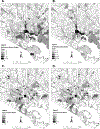Alcohol Outlets, Neighborhood Retail Environments, and Pedestrian Injury Risk
- PMID: 30102415
- PMCID: PMC6167150
- DOI: 10.1111/acer.13844
Alcohol Outlets, Neighborhood Retail Environments, and Pedestrian Injury Risk
Abstract
Background: Alcohol outlet density has been associated with increased pedestrian injury risk. It is unclear whether this is because alcohol outlets are located in dense retail areas with heavy pedestrian traffic or whether alcohol outlets contribute a unique neighborhood risk. We aimed to compare the pedestrian injury rate around alcohol outlets to the rate around other, similar retail outlets that do not sell alcohol.
Methods: A spatial analysis was conducted on census block groups in Baltimore City. Data included pedestrian injury emergency medical services (EMS) records from January 1, 2014 to April 15, 2015 (n = 848); locations of alcohol outlets licensed for off-premise (n = 726) and on-premise consumption (n = 531); and corner (n = 398) and convenience stores (n = 192) that do not sell alcohol. Negative binomial regression was used to determine the relationship between retail outlet count and pedestrian injuries, controlling for key confounding variables. Spatial autocorrelation was also assessed and variable selection adjusted accordingly.
Results: Each additional off-premise alcohol outlet was associated with a 12.3% increase in the rate of neighborhood pedestrian injury when controlling for convenience and corner stores and other confounders (incidence rate ratio [IRR] = 1.123, 95% confidence interval [CI] = 1.065, 1.184, p < 0.001). The attributable risk was 4.9% (95% CI = 0.3, 8.9) or 41 additional injuries. On-premise alcohol outlets were not significant predictors of neighborhood pedestrian injury rate in multivariable models (IRR = 0.972, 95% CI = 0.940, 1.004, p = 0.194).
Conclusions: Off-premise alcohol outlets are associated with pedestrian injury rate, even when controlling for other types of retail outlets. Findings reinforce the importance of alcohol outlets in understanding neighborhood pedestrian injury risk and may provide evidence for informing policy on liquor store licensing, zoning, and enforcement.
Keywords: Alcohol Availability; Alcohol Outlets; Neighborhood; Pedestrian Injury; Spatial Analysis.
© 2018 by the Research Society on Alcoholism.
Figures

Similar articles
-
Alcohol outlets, drug paraphernalia sales, and neighborhood drug overdose.Int J Drug Policy. 2021 Sep;95:103289. doi: 10.1016/j.drugpo.2021.103289. Epub 2021 May 11. Int J Drug Policy. 2021. PMID: 33984684 Free PMC article.
-
Using Zoning as a Public Health Tool to Reduce Alcohol Outlet Oversaturation, Promote Compliance, and Guide Future Enforcement: a Preliminary Analysis of Transform Baltimore.J Urban Health. 2020 Aug;97(4):568-582. doi: 10.1007/s11524-020-00453-7. J Urban Health. 2020. PMID: 32632795 Free PMC article.
-
Neighbourhood alcohol environment and injury risk: a spatial analysis of pedestrian injury in Baltimore City.Inj Prev. 2019 Oct;25(5):350-356. doi: 10.1136/injuryprev-2018-042736. Epub 2018 Mar 27. Inj Prev. 2019. PMID: 29588410 Free PMC article.
-
A review of the validity and reliability of alcohol retail sales data for monitoring population levels of alcohol consumption: a Scottish perspective.Alcohol Alcohol. 2013 Mar-Apr;48(2):231-40. doi: 10.1093/alcalc/ags098. Epub 2012 Aug 26. Alcohol Alcohol. 2013. PMID: 22926649 Free PMC article. Review.
-
Alcohol Consumption and the Physical Availability of Take-Away Alcohol: Systematic Reviews and Meta-Analyses of the Days and Hours of Sale and Outlet Density.J Stud Alcohol Drugs. 2018 Jan;79(1):58-67. J Stud Alcohol Drugs. 2018. PMID: 29227232 Review.
Cited by
-
Alcohol outlets, drug paraphernalia sales, and neighborhood drug overdose.Int J Drug Policy. 2021 Sep;95:103289. doi: 10.1016/j.drugpo.2021.103289. Epub 2021 May 11. Int J Drug Policy. 2021. PMID: 33984684 Free PMC article.
-
Using SaTScan to identify and map nightlife areas in Philadelphia, PA.J Maps. 2024;20(1):2394505. doi: 10.1080/17445647.2024.2394505. Epub 2024 Sep 17. J Maps. 2024. PMID: 40791745
-
A Multilevel Model of Alcohol Outlet Density, Individual Characteristics and Alcohol-Related Injury in Argentinean Young Adults.Can J Addict. 2020 Dec;11(4):32-39. doi: 10.1097/cxa.0000000000000097. Can J Addict. 2020. PMID: 33585673 Free PMC article.
-
Comparing alcohol involvement among injured pedalcycle and motorcycle riders across three national public-use datasets.Traffic Inj Prev. 2024;25(8):1023-1030. doi: 10.1080/15389588.2024.2364358. Epub 2024 Jun 26. Traffic Inj Prev. 2024. PMID: 38923430 Free PMC article.
-
Using Zoning as a Public Health Tool to Reduce Alcohol Outlet Oversaturation, Promote Compliance, and Guide Future Enforcement: a Preliminary Analysis of Transform Baltimore.J Urban Health. 2020 Aug;97(4):568-582. doi: 10.1007/s11524-020-00453-7. J Urban Health. 2020. PMID: 32632795 Free PMC article.
References
-
- Anderson CL, Dominguez KM, Hoang T V, Rowther AA, Carroll MC, Lotfipour S, Hoonpongsimanont W, Chakravarthy B (2012) An Analysis of Distance from Collision Site to Pedestrian Residence in Pedestrian versus Automobile Collisions Presenting to a Level 1 Trauma Center. Ann Adv Automot Med 56:31–6. - PMC - PubMed
-
- Baltimore City Department of Planning (2009) Alcohol Outlet Density Reduction in Baltimore City: Summary. Available at: http://www.rewritebaltimore.org/pdf/AlcoholOutletDensityReduction.pdf
-
- Bivand RS, Pebesma E, Gomez-Rubio V (2013) Applied Spatial Data Analysis with R, 2nd ed. New York, Springer.
Publication types
MeSH terms
Grants and funding
LinkOut - more resources
Full Text Sources
Other Literature Sources
Medical
Miscellaneous

